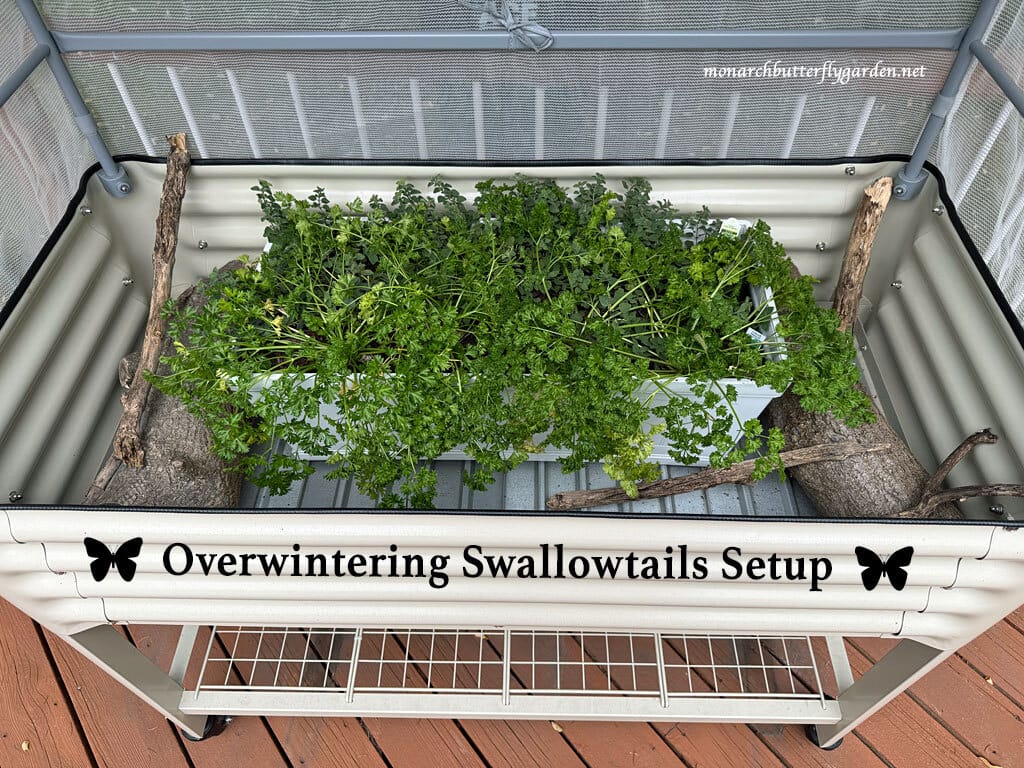- Grow the Migration
- Posts
- Are Native-ONLY Wildlife Gardens Starving Migrating Monarchs❓☠️ 🦋 😱
Are Native-ONLY Wildlife Gardens Starving Migrating Monarchs❓☠️ 🦋 😱
Which plants do late-season monarchs favor...and why?
Happy Sunday Good GROWer,
fall has finally arrived after an extended summery reprieve…we haven’t had a killing frost in the bold north, but we flirted with freezing temps a few nights ago. 🥀
The monarchs have left the garden, but one stray male monarch was here until Thursday. Going by his leisurely pace, he’s most likely not part of the migration generation, though he looked fresh enough to make it. 🦋
Yesterday, I saw a monarch with wrinkled wings crash land on local pickleball courts. I picked him up and attempted to place him on a nearby bush, but he took flight and was hopefully able to survive for at least one more beautiful fall day…
Meanwhile, the swallowtail caterpillars continue their race against the clock….🌿🐛🕕🥶

Raising Report
Our eastern black swallowtail caterpillars have grown a lot in the past week and are all probably 3-4 instars…the two largest possibly 5th instar:
Caterpillar Instar Info ⬅️ (similar for black swallowtails)
When I found these small caterpillars they were completely spaced out across the curled parsley:

October Swallowtails 😮
But, over the past week, 3 of 5 have found their way to each other:

Growing Close
It’s surprising (and hopeful!) to see how much they have progressed in such a short period…do you even recognize them? 🌿🐛 👀
Over the past week, we kept them inside for two days because:
one night was close to freezing (which could have killed both caterpillars and parsley)
roofing project (loud on deck and debris flying around)
We were simply able to roll the entire raised bed cart from our deck into our kitchen. They have since been rolled back out to the deck.
Having the right raising setup (the same we use for raising monarchs outdoors) has been the perfect solution so far…
Outdoor Raising Setup
We removed the container plant from our deck railing and placed it directly inside the outdoor cage:

Three additions not seen in the photo above are:
4' x 6' heavy duty tarp ⬅️ (secure this to top of cage to keep chrysalises dry from overhead precipitation that could make them fall...if cage location protects them from rain, you don't need this)
Four 36" bungee cords ⬅️ (2 linked together on each side to secure tarp)
I stuck branches directly into the container soil that they can crawl up to form their chrysalis on. They tend to crawl around a lot before they do this, so who knows where they will end up? 🤷🏽♂️
The tarp and bungee cords won’t be necessary when we move them to their final overwintering spot under an awning next to our house. For now, we have the cage on the far side of the deck where they’re are getting a good amount of sun so metamorphosis won’t slow down at this critical part of the season…during spring/summer, they are always in this sunny location during the day, unless there is stormy weather.
It might be late to utilize this outdoor raising setup in 2025, but this could make an amazing holiday butterfly gift for 2026! 🎁🎄
🌿 Garden PLANT Report 🌺
Typically, nectar is getting scarce this time of the year, especially if you only plant natives.
Natively, our New England Asters are a favorite nectar source for bees, but less for monarchs. I think the butterflies would use it more if there were less ‘smallinators’ buzzing around it. I often see butterflies ‘bumped off’ blooms by wasps and bees.
Other native perennials are past their prime and finished for the season including liatris spp, stiff goldenrod, showy goldenrod, and tall phlox.
For monarchs, our non-native blooms support the bulk of late-migrating butterflies on their way to Mexico including Mexican sunflowers, zinnias, lantana, and tropical milkweed.
Which leads to the controversial question….
Garden LIFE Report
We had a roof project going on this week so garden activity was temporarily interrupted. Of note this week:
Vanessa atalanta (Red Admiral Butterfly)- like the painted ladies from your last newsletter, these have been rare in our 2025 garden
Resident Green Frog Disappears…again (it’s possible he is now hibernating somewhere close by)
Snake Butt Returns…again(this was actually all I saw of the snake as it slithered away from the water feature
1 Last Male Monarch left the garden Thursday
Last Hummingbird- I also saw the last hummer on Thursday in our annual ‘Amistad’ Salvia…I think this is the latest I have ever seen a hummingbird in our Minnesota garden.
Turkeys still making daily visits- this flock of about 20 birds walks through our front yard twice daily…down the street each morning, and then back up each evening
Coming Up Next?
Fall planting can finally continue now that the temps are seasonably cool and it’s time to decide which plants we’re overwintering indoors and why….the list seems to shrink every year as we’ve planted more perennials, but there will still be a select few.
Until next time,
Tony your Butterfly Guide
